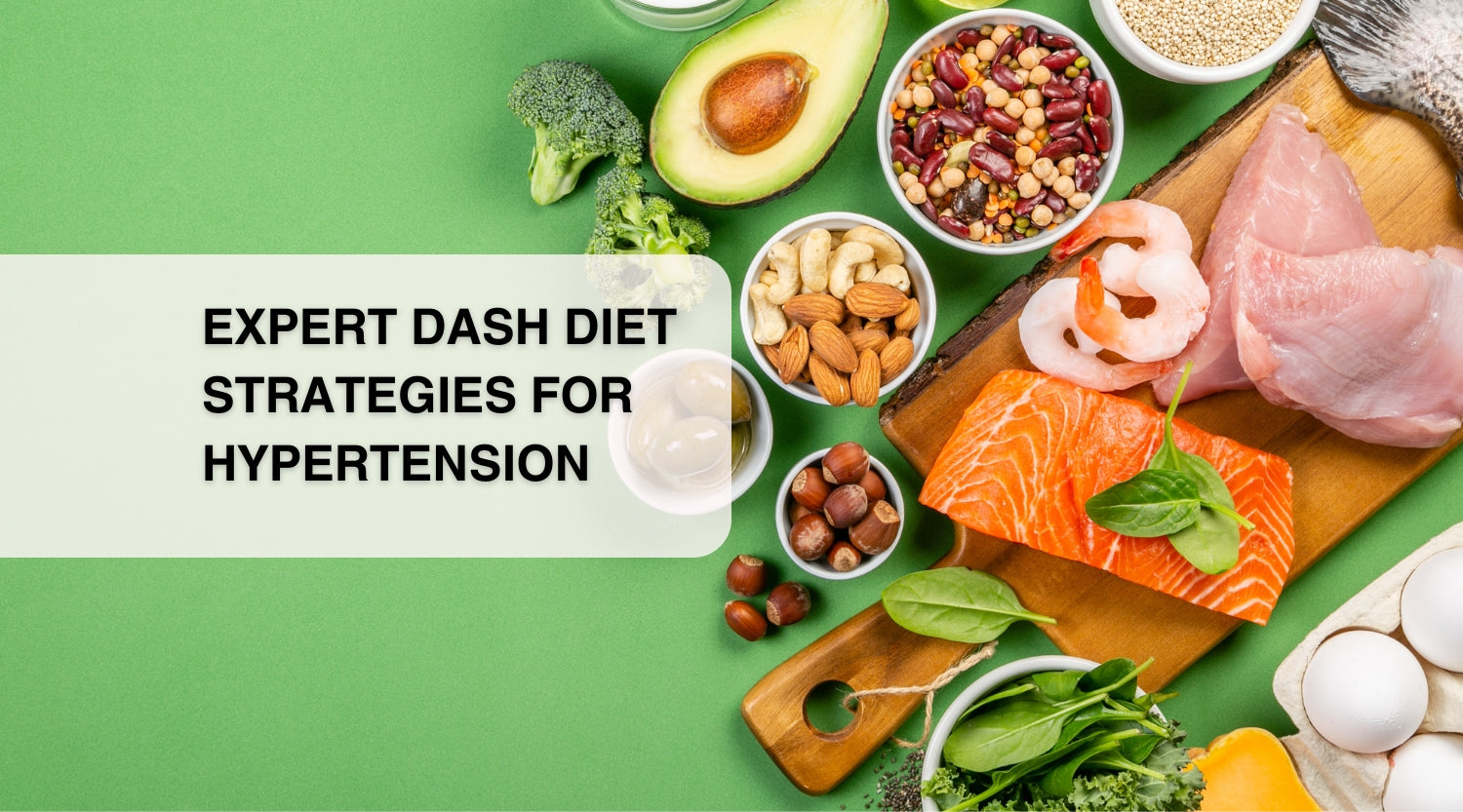
Mastering the DASH Diet: Expert Strategies for Combating Hypertension
Hypertension, often referred to as the "silent killer," is a significant public health issue affecting millions worldwide. Left unmanaged, it can lead to severe complications such as heart disease, stroke, and kidney failure. Fortunately, diet plays a crucial role in controlling and preventing hypertension. The DASH diet (Dietary Approaches to Stop Hypertension) is widely recognized as one of the most effective dietary plans for managing blood pressure. This blog provides an in-depth look into the DASH diet and offers expert strategies for incorporating it into your lifestyle.
Understanding Hypertension and Dietary Strategies
The DASH diet was explicitly developed to lower blood pressure without needing medication. It emphasizes consuming foods rich in potassium, calcium, and magnesium—nutrients known to help control blood pressure. The diet limits foods that are high in sodium, saturated fats, and added sugars, which can contribute to hypertension.

Key Nutrients to Look for in a Hypertension Diet
A hypertension diet should include key nutrients that help manage blood pressure. Look for foods high in potassium, magnesium, and fiber. These nutrients aid in relaxing blood vessels and improving blood flow. A diet rich in calcium and omega-3 fatty acids is also beneficial. These help to reduce artery inflammation and enhance heart health. When shopping, choose fresh and whole foods over processed items. Limit intake of sodium, as it raises blood pressure in sensitive individuals.
Top Blood Pressure-Lowering Foods
The Benefits of Fresh Garlic and Tomatoes
Fresh garlic and tomatoes offer a powerful duo in the fight against hypertension. Garlic is known for its allicin content, which helps to relax blood vessels, thus lowering blood pressure. It also aids in overall cardiovascular health by reducing arterial stiffness. Including a clove or two of garlic in daily meals can have significant health benefits. Tomatoes, on the other hand, are rich in lycopene, an antioxidant that has been linked to reductions in blood pressure. They also contain potassium, which assists in balancing the adverse effects of sodium and helps to maintain proper heart function. To harness the benefits of these natural blood pressure-lowering foods, here are some suggestions:
- Add crushed garlic to sauces, soups, and dressings.
- Snack on cherry tomatoes or include sliced tomatoes in salads.
- Blend fresh tomatoes into a heart-healthy gazpacho or tomato juice.
With these simple dietary additions, you can take a delicious step towards managing your hypertension.
The Role of Potassium-Rich Foods in Hypertension Control
Potassium is a key mineral in managing hypertension. It helps to balance sodium levels and ease tension in blood vessel walls, lowering blood pressure. A diet rich in potassium may include:
- Bananas, which are widely known as a great source of potassium.
- Sweet potatoes, offering a nutritious boost with both potassium and fiber.
- Spinach, which is not only rich in potassium but also magnesium and iron.
- Avocados, brimming with heart-healthy fats and potassium.
- Beans and lentils, providing a fill-the-plate option that delivers potassium, protein, and fiber.
Incorporating these foods into your diet can make a significant difference in blood pressure control and overall heart health.
Integrating Blood Pressure-Friendly Foods into Daily Life
Tips for Preparing Hypertension-Conscious Meals
Creating meals that support healthy blood pressure is key. Here are simple tips:
- Start with whole foods. Choose unprocessed ingredients.
- Use less salt. Season with herbs and spices instead.
- Cook with healthy fats like olive oil or avocado oil.
- Include a good mix of potassium-rich foods like sweet potatoes and bananas.
- Add leafy greens such as spinach or kale to your dishes.
- Prepare lean proteins like fish or skinless chicken.
- Opt for high-fiber options like brown rice or quinoa.
- Stay hydrated with water and limit high-sugar drinks.
Following these simple steps can make a big impact on managing hypertension.
Expert Strategies for Implementing the DASH Diet
- Start Gradually: Transitioning to the DASH diet doesn't have to be overwhelming. Start by making small changes, such as adding an extra serving of vegetables to your meals or replacing white bread with whole-grain options.
- Plan Your Meals: Planning meals in advance can help you stick to the DASH guidelines. Prepare a weekly menu that includes plenty of fruits, vegetables, and whole grains.
- Mind Your Portions: Portion control is essential in the DASH diet. Use measuring cups or a food scale to ensure you’re eating the right amounts of each food group.
- Snack Wisely: Choose heart-healthy snacks such as nuts, fresh fruit, or low-fat yogurt. Avoid processed snacks that are high in sodium and unhealthy fats.
- Stay Hydrated: Drink plenty of water throughout the day. Water helps regulate blood pressure and supports overall health. Limit sugary drinks and alcohol, which can contribute to hypertension.
- Exercise Regularly: While the DASH diet is effective on its own, combining it with regular physical activity can further reduce blood pressure. Aim for at least 150 minutes of moderate-intensity exercise per week.
- Monitor Your Progress: Monitor your blood pressure regularly to see how the DASH diet benefits you. Keeping a food diary to monitor your dietary habits is also helpful.
Real-Life Success Stories
Many people have successfully lowered their blood pressure and improved their health by following the DASH diet. For instance, a study published in the Journal of the American Medical Association found that participants who followed the DASH diet experienced significant reductions in blood pressure, even without weight loss or additional physical activity.
In summary, the DASH diet is a proven, practical approach to managing and preventing hypertension. It offers a balanced and sustainable way to improve heart health by emphasizing nutrient-rich foods and limiting sodium. Adopting the DASH diet can lead to lasting health benefits if you’re looking to prevent hypertension or manage existing high blood pressure.
References
- National Heart, Lung, and Blood Institute. "DASH Eating Plan." DASH Eating Plan | NHLBI, NIH
- U.S. Department of Health and Human Services. "Your Guide to Lowering Blood Pressure with DASH." https://www.nhlbi.nih.gov/education/dash/resources
- Appel, L.J., et al. "A clinical trial of the effects of dietary patterns on blood pressure." New England Journal of Medicine, 1997. https://www.nejm.org/doi/full/10.1056/NEJM199704173361601
- Sacks, F.M., et al. "Effects on blood pressure of reduced dietary sodium and the Dietary Approaches to Stop Hypertension (DASH) diet." New England Journal of Medicine, 2001. https://cir.nii.ac.jp/crid/1571417124950613248
- Tan, Juanyi, Christy Wang, and A. Janet Tomiyama. "Dietary Approaches to Stop Hypertension (DASH) diet and mental well-being: a systematic review." Nutrition Reviews 82.1 (2024): 60-75. https://academic.oup.com/nutritionreviews/article-abstract/82/1/60/7136007
- Siervo, Mario, et al. "Effects of the Dietary Approach to Stop Hypertension (DASH) diet on cardiovascular risk factors: a systematic review and meta-analysis." British Journal of Nutrition 113.1 (2015): 1-15. doi:10.1017/S0007114514003341
